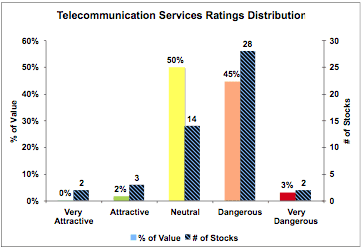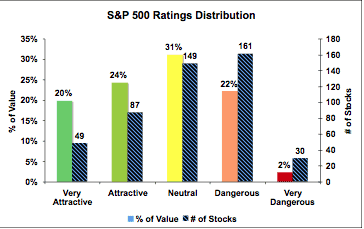We recommend investors avoid Telecommunication Sector ETF as that sector is one 4 sectors to get our “dangerous” rating. This sector is dominated by two stocks AT&T (T) and Verizon Communications (VZ). Combined they represent over 65% of the market cap of the 49 companies we cover in that sector. Neither stock gets better than our “neutral” rating. Investors looking for exposure to the Telecommunications Sector may find it very difficult to find an ETF that has many “attractive-or-better” rated stocks.
Not all Telecommunication Sector ETFs are made the same. They all tend to hold different companies and a different number of companies. For example, according to Marco Polo XTF, each of the top five ETFs by market cap all have different numbers of holdings. iShares Dow Jones US Telecommunications (IYZ) has 32 cap-weighted holdings, Vanguard Telecommunications Services Index Fund (VOX) has 39 cap-weighted holdings, Telecom HOLDRS (TTH) has only 12 cap-weighted holdings and, Broadband HLDRS (BDH) and Wireless HLDRS (WMH) have only 16 cap-weighted holdings. The point is that depending on the holdings and the allocations for a given ETF, the ETF can have radically different performance. After all, that is what professional managers are paid to do. Accordingly, passively-managed ETFs put the burden of stock-selection diligence on the investor.
I am not saying that investors need professional managers to build custom ETFs. But I am saying that investors need to understand the holdings and allocations to each holding within an ETF in order to be sure they are getting what they want from the ETF.
Below are our recommendations:
If you require exposure to the Telecommunications sector:
We recommend investors buy only the Very Attractive and Attractive stocks in the Telecommunications sector, not a Telecommunications ETF. 98% (in terms of market value) of stocks in the Telecommunication Sector are Neutral-or-worse- rated stocks. This compares poorly to the Consumer Staples Sector, where 73% (in terms of market value of stocks) of stocks get and Attractive-or-better rating.
If you require exposure to a sector ETF:
We recommend investors buy a Consumer Staples ETF over a Telecommunications ETF because the Consumer Staples sector allocates 73% of the value to Attractive-or-better-rated stocks compared to 2% for the Telecommunications sector. See our U.S. Equity ETF Strategic Roadmap report to compare sector and index ETFs.
If you require exposure to a Telecommunications ETF or an index ETF:
We recommend investors buy an S&P 500 ETF instead of a Telecommunications ETF.
The following figures explain my conclusions above.
Figure 1 maps the Risk/Reward composition of the Telecommunications sector’s holdings and capital allocation.
Figure 1: Telecommunications Sector – Capital Allocation & Holdings by Risk/Reward Rating

The Telecommunication Services sector has just two Very Attractive-rated stocks that effectively make up 0% of the sector’s value. Only 3% of the sector’s capital is allocated to Very Dangerous-rated stocks. However, allocating 48% of its capital to Dangerous-or-worse-rated stocks gives the Telecommunication Services sector a Dangerous Overall Risk/Reward Rating.
Therefore, investors should be sure that they assess the holdings of any Telecommunication sector ETF to ensure it is not too heavily weighted in Neutral-or-worse-rated stocks. Telecommunication Sector ETFs could offer investors a more attractive Risk/Reward profile by (1) adding Attractive-rated holdings in place of Neutral-or-worse-rated holdings and/or (2) allocating more capital to the Attractive-rated holdings instead of Neutral-or-worse-rated holdings.
Figure 2 maps the Risk/Reward composition of the S&P 500 and its capital allocation.
Figure 2: S&P 500 – Capital Allocation & Holdings by Rating

The S&P 500 allocates 44% of its value to Attractive-or-better-rated stocks while the Telecommunications sector allocates 21% of its value to Attractive-or- better-rated stocks. The S&P 500 allocates only 24% of its value to Dangerous-or-worse-rated stocks while the Telecommunications sector allocates 48% of its value to Dangerous-or-worse-rated stocks.
Comparing their ratings distributions, the S&P 500 shows a better allocation of capital and is a more appealing option for investors looking to buy an ETF. For example, the Telecommunication Sector allocates nearly twice as much value to ‘very dangerous’ and ‘dangerous’ stocks.
More details are available in our report on Telecommunication Sector ETFs.
This analysis and our conclusions are based on bottoms-up analysis of each of the 3000 stocks we cover, including nearly every Telecommunication sector company. Our individual company research leverages detailed review of Telecommunication Footnotes and MD&A in SEC filings to deliver clients the whole truth about the profitability and valuation of every stock.
